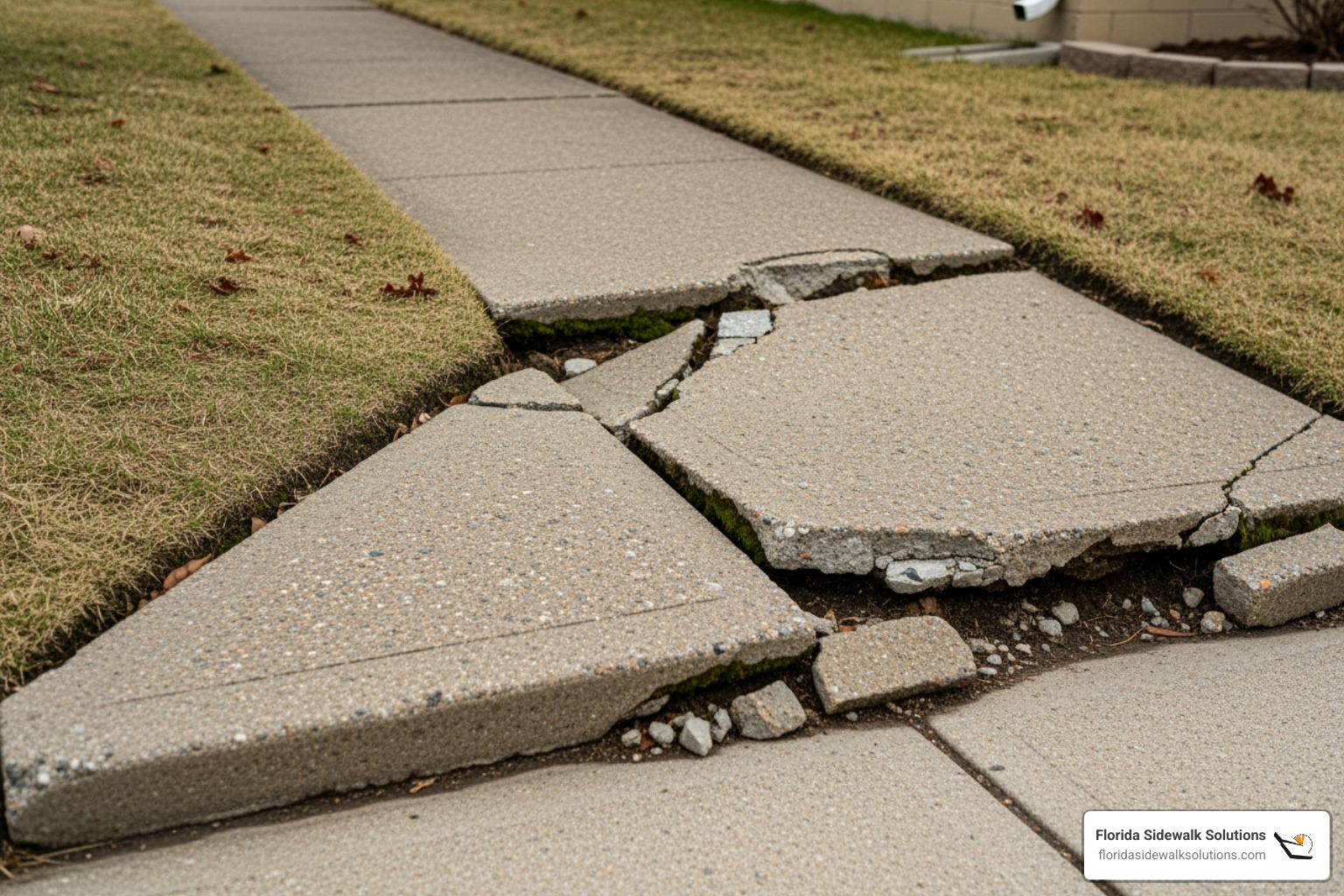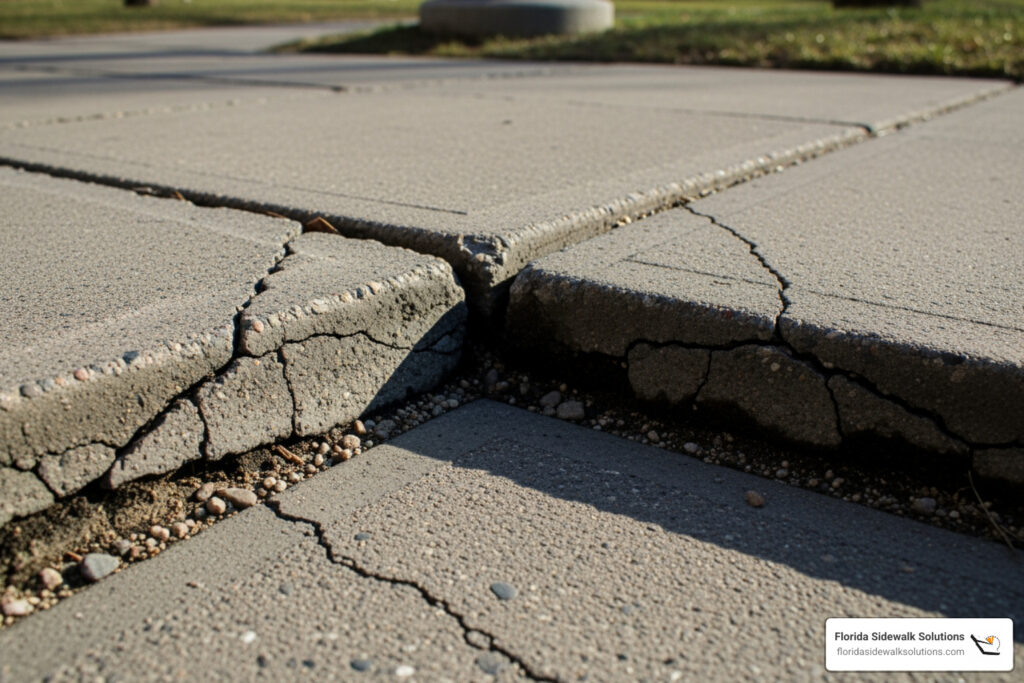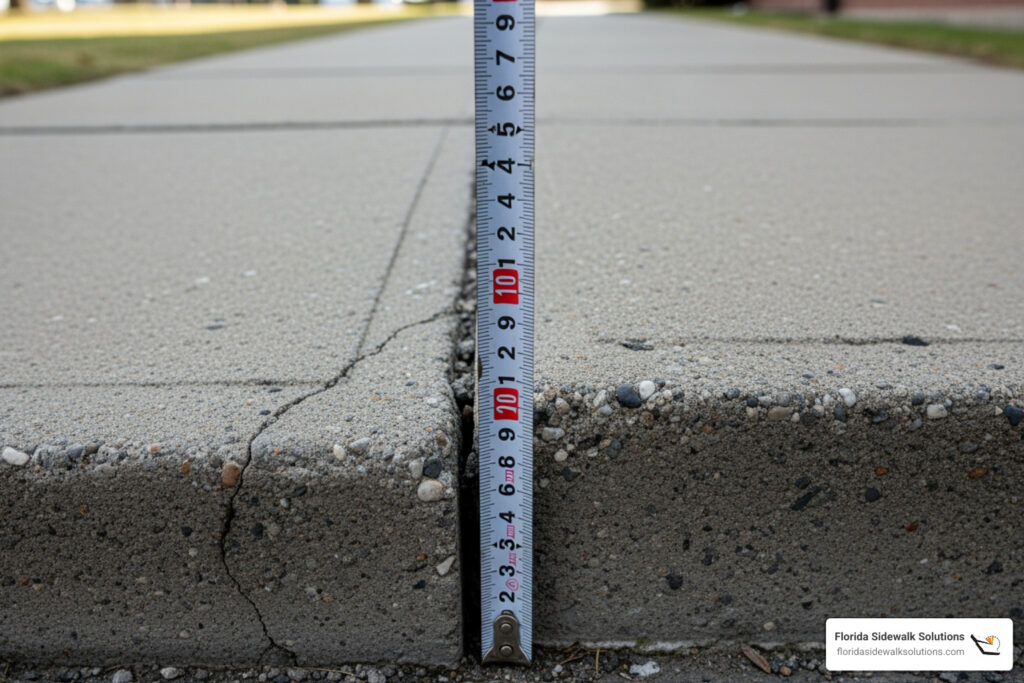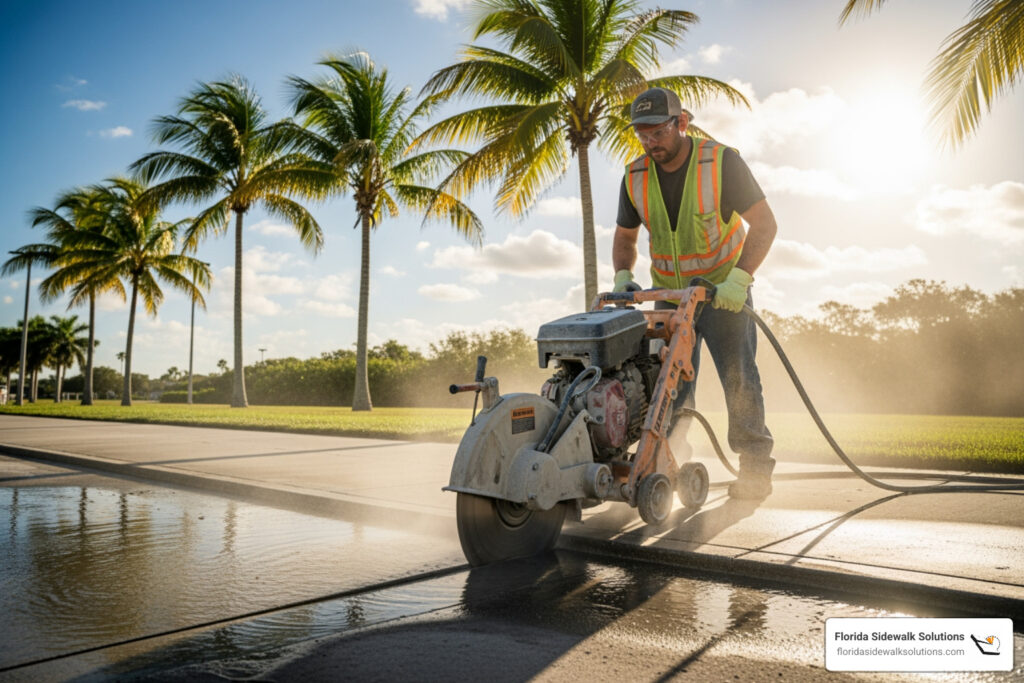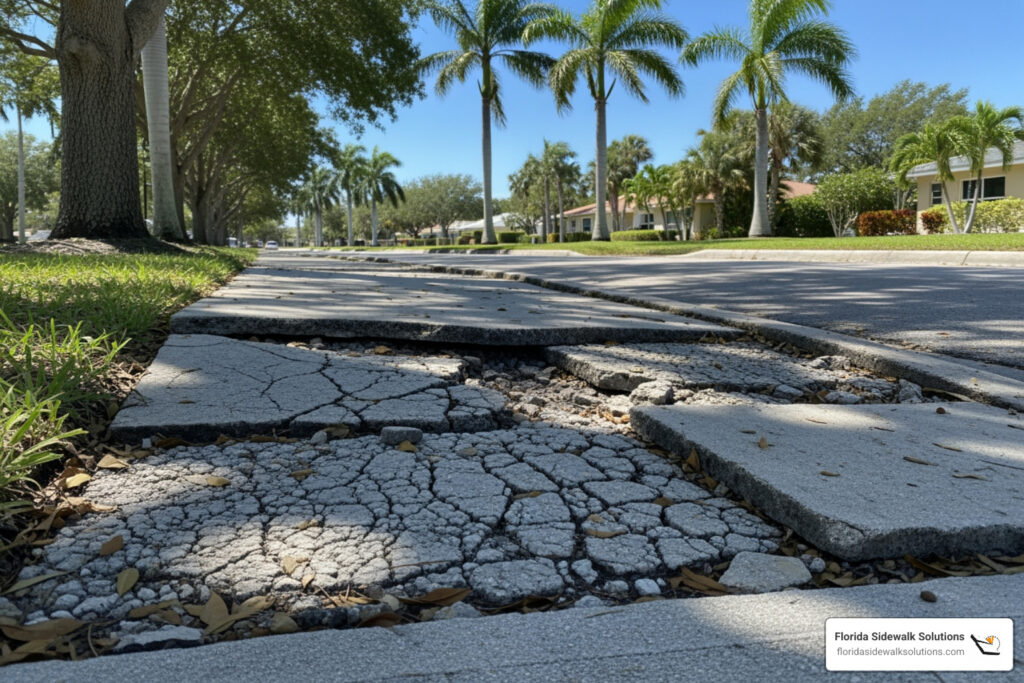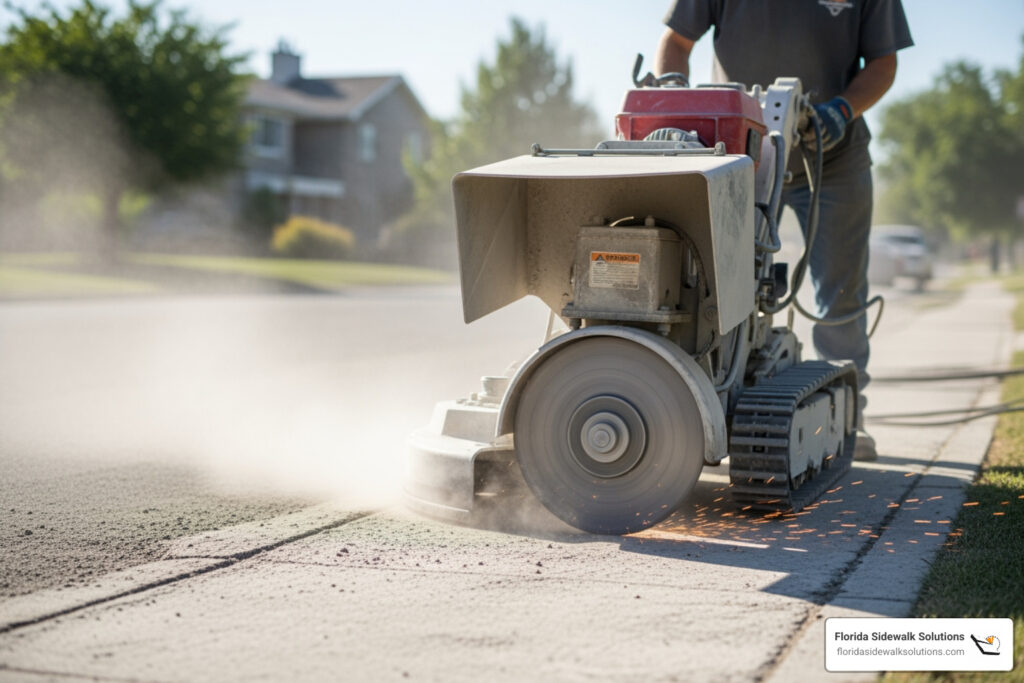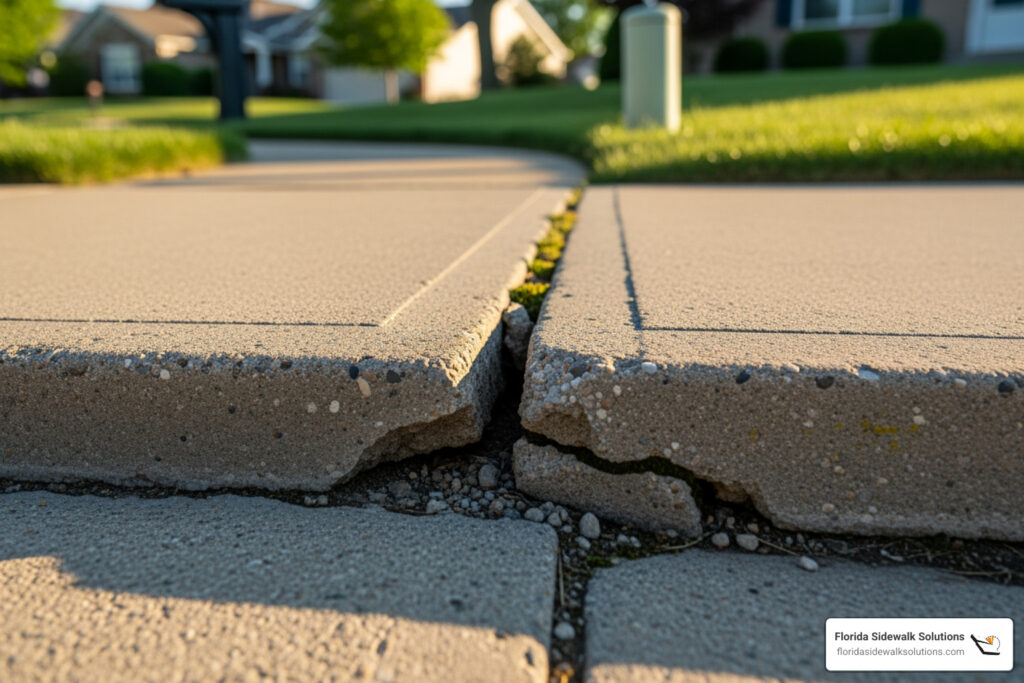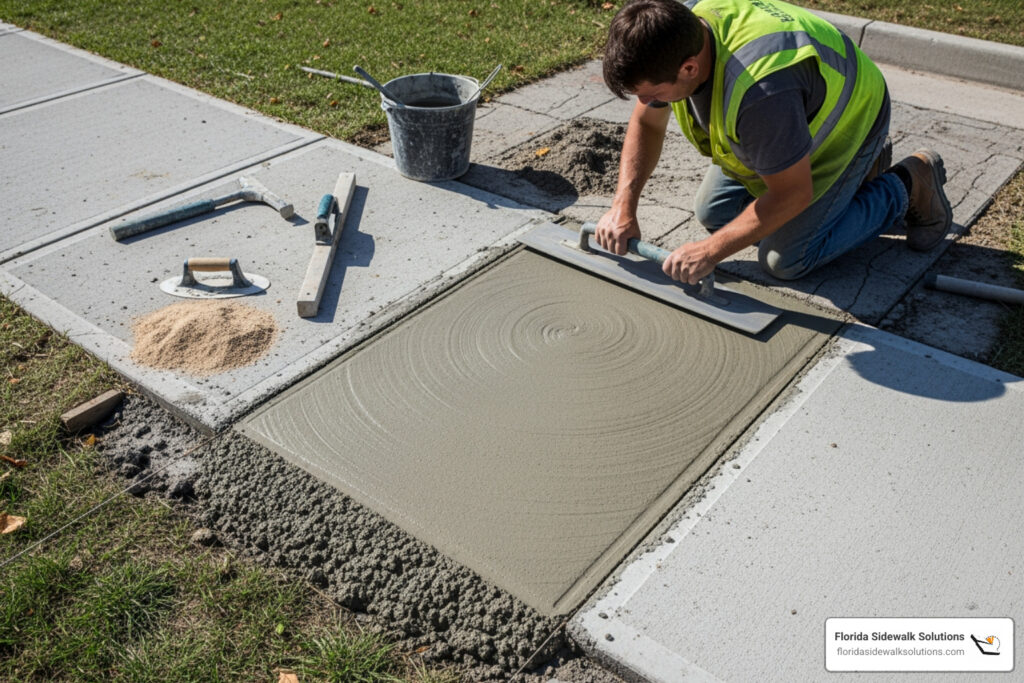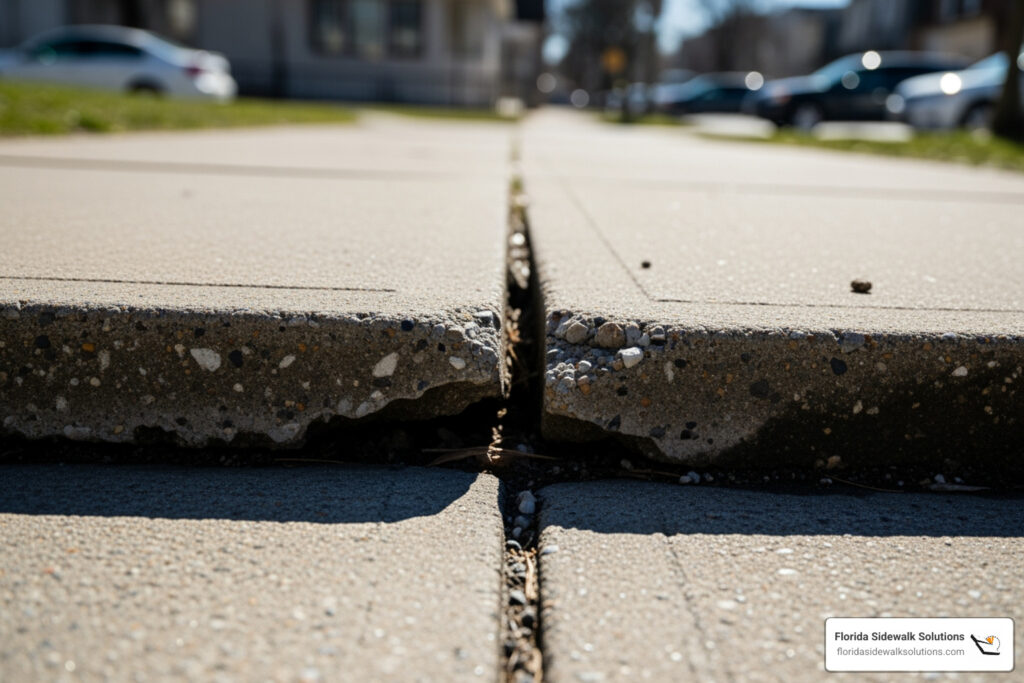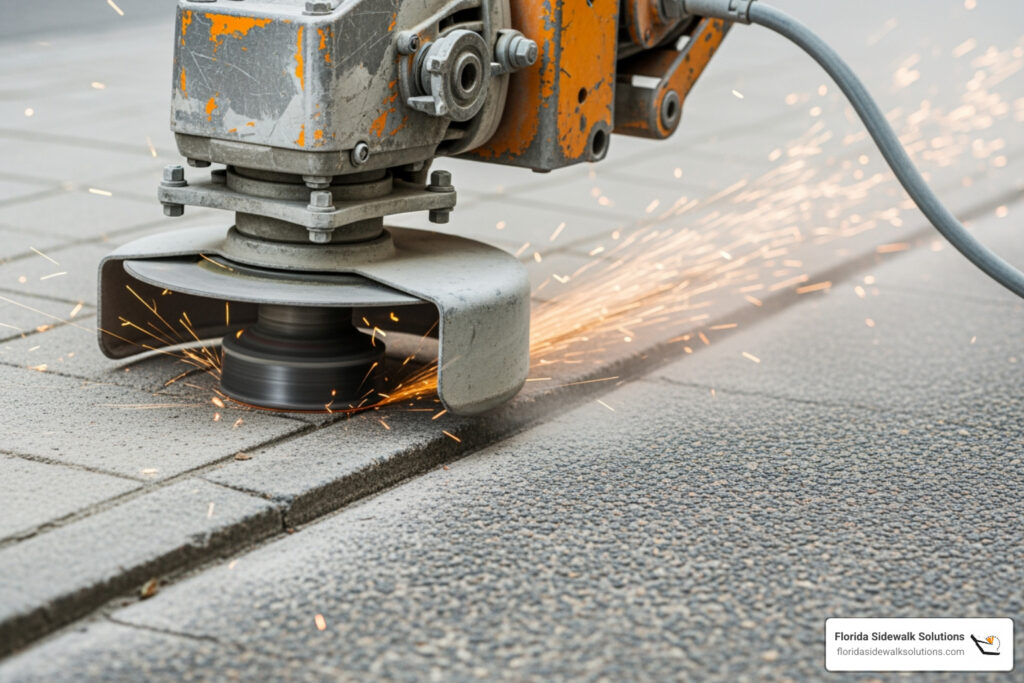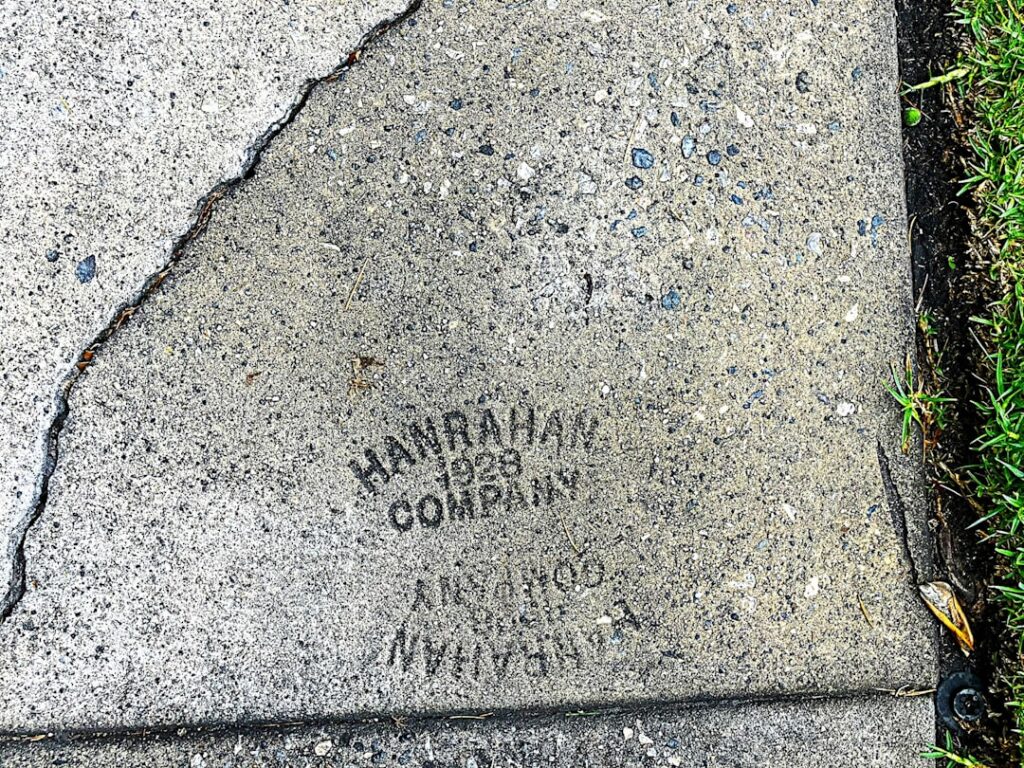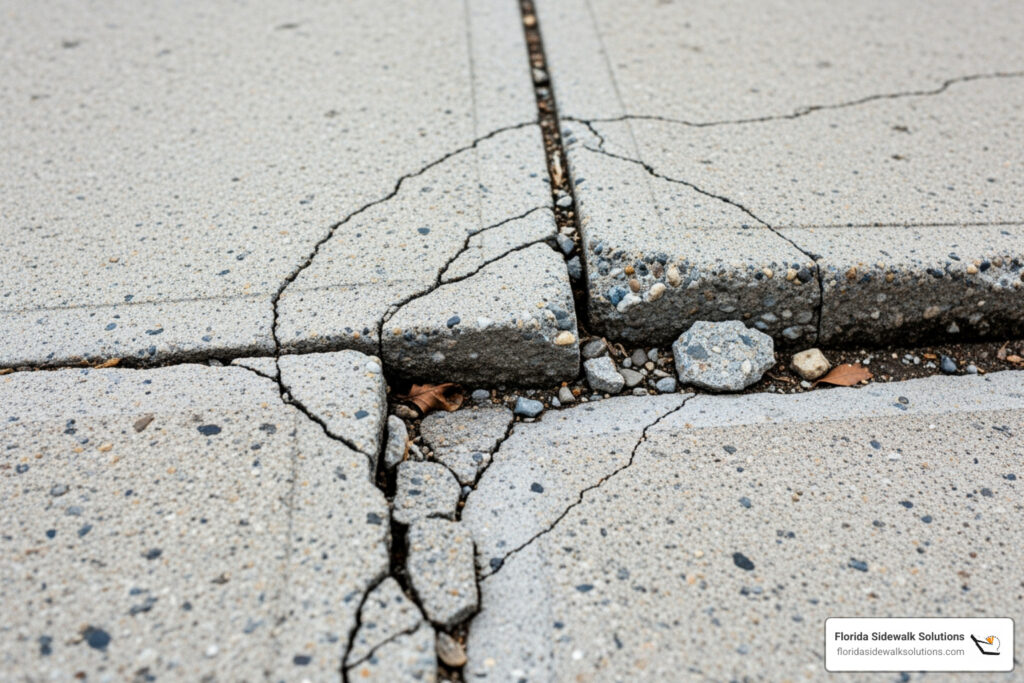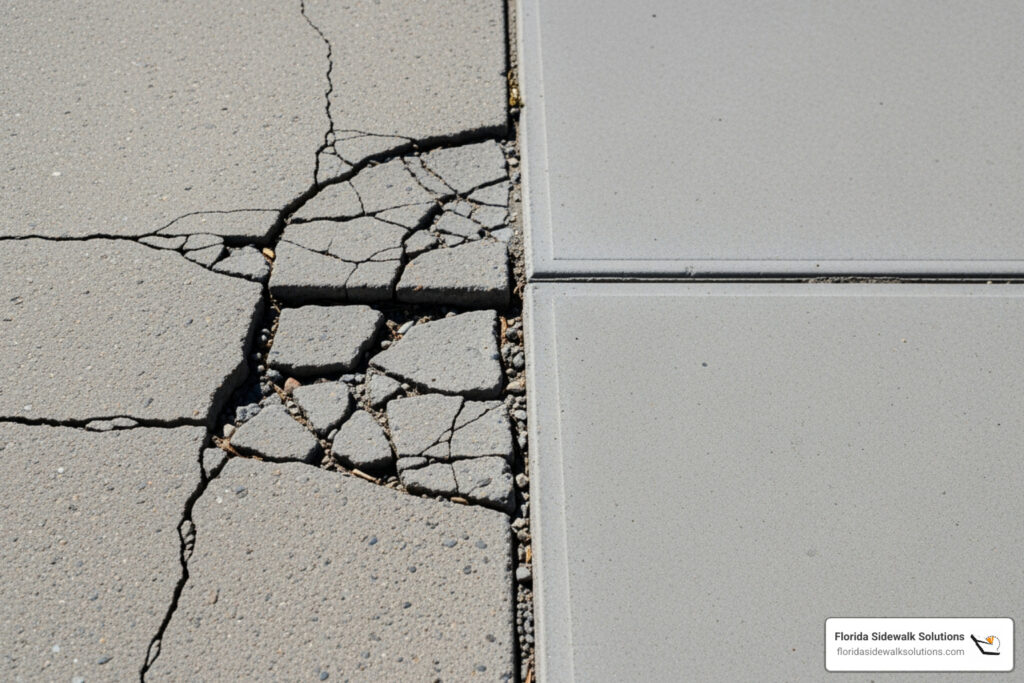Why Residential Concrete Sidewalk Repair is Critical for Safety and Compliance
Residential concrete sidewalk repair addresses safety hazards and liability risks for homeowners and municipalities. Here are the key repair methods and considerations:
Common Repair Methods:
- Precision Concrete Cutting – Most cost-effective for trip hazards (up to 70% savings vs. replacement)
- Crack Filling – For minor surface cracks ($5-$100 DIY materials)
- Slab Replacement – Only when concrete is severely damaged (average $1,320 per slab)
- Grinding/Scabbling – Traditional methods, less precise than cutting
When to Repair vs Replace:
- Repair: Structurally sound concrete with trip hazards or minor damage
- Replace: Severely cracked, crumbling, or structurally compromised slabs
Cost Factors:
- Repair method chosen
- Size of damaged area
- Geographic location and labor rates
- Permit requirements
According to the National Safety Council, 32% of all nonfatal injuries in 2019 resulted from falls. Uneven sidewalks create significant trip hazards that expose property owners to liability and fail ADA compliance standards.
Whether you’re a municipal manager or a homeowner, understanding your repair options is essential. Traditional methods like grinders are being replaced by more precise techniques that deliver better results at lower costs.
The key is identifying damage early. While minor cracks can be a DIY fix, trip hazards require professional assessment to ensure ADA compliance and lasting safety.

Terms related to residential concrete sidewalk repair:
Identifying Common Sidewalk Damage and Hazards
A slightly raised sidewalk or a growing crack isn’t just an inconvenience; it’s an accident waiting to happen. These issues are serious trip hazards.

Understanding common sidewalk damage is the first step in residential concrete sidewalk repair. A ‘little bump’ could be a sunken concrete slab from soil erosion, while a lifted slab is often caused by tree roots. Spalling (flaking or crumbling) and pitting (small holes) are also common signs of wear.
Then there are the cracks. Tree root damage and water damage from poor drainage often develop gradually, creating significant problems over time. The good news is that most of these issues are prime candidates for Uneven Sidewalk Repairs rather than complete replacement.
What to Look For
Knowing what to look for is crucial. Hairline cracks, while seemingly minor, allow water to penetrate the concrete, leading to bigger problems. Structural cracks are deeper, wider, and signal more serious underlying issues. If a crack is wide enough to fit a quarter, it needs immediate attention.
Look for crumbling edges where the concrete is breaking away. Slab displacement, where one section is higher than another, is an obvious trip hazard. Water pooling after rain is another clear sign your sidewalk is no longer level.
For a deeper dive into recognizing when these issues need immediate attention, check out When Residential Walkway Repair is Essential.
Why Minor Issues Become Major Liabilities
Sidewalk problems don’t fix themselves; they only get worse. A seemingly innocent trip and fall risk can lead to serious legal and financial consequences, including insurance claims, medical bills, and lawsuits.
ADA compliance isn’t just for businesses. Residential properties, especially in HOAs, must also consider accessibility standards. Non-compliance can lead to fines and costly mandatory repairs.
Your property value also takes a hit. Damaged sidewalks signal poor maintenance and future repair costs to potential buyers.
Finally, escalating damage means a minor, cheap fix can become an expensive professional repair if ignored. Addressing these issues with proper ADA Compliance Repairs for Your Sidewalk makes both safety and financial sense.
The Florida Sidewalk Solutions Method: Precision Concrete Cutting
When it comes to residential concrete sidewalk repair, most trip hazards don’t require a sledgehammer. Instead of tearing up good concrete, our precision cutting method offers a smarter solution that saves time, money, and hassle. You wouldn’t replace a car for a small dent, and the same logic applies to your sidewalk. Our method fixes the exact problem without disturbing sound concrete.
Precision Concrete Cutting for Trip Hazard Removal
Our patented technology is a game-changer. Unlike old-school grinding that leaves rough, uneven surfaces, our specialized cutting equipment creates smooth, safe transitions.

We create a no-trip edge—a perfectly smooth, gradual slope that eliminates the vertical displacement that causes falls. It’s an engineered solution, not just concrete removal. The result is a cost-effective solution, often up to 70% cheaper than replacement, with minimal disruption. There’s no prolonged construction noise, blocked access, or waiting for new concrete to cure.
Crucially, every precision repair we complete meets strict ADA compliance standards, ensuring sidewalks are safe and accessible for everyone.
You can learn more about Why is Concrete Cutting the Best Sidewalk Repair Method? on our detailed guide.
Why Choose Precision Cutting Over Other Methods
Conventional scabblers and grinders often create more problems, leaving rough, non-compliant surfaces and new trip hazards. Our precision cutting reaches edges and angles grinders can’t, delivering a clean, smooth finish every time.
Full slab removal and replacement is expensive, disruptive, and usually unnecessary unless the concrete is severely compromised. Our precision repair solves the problem in hours, not days.
Our method creates a smooth, ADA-compliant transition that is fast, clean, and minimally disruptive. Your sidewalk is ready for use almost immediately.
Comparing Sidewalk Repair Approaches
| Factor | Precision Cutting (Florida Sidewalk Solutions) | Conventional Grinding | Full Replacement |
|---|---|---|---|
| Cost | Low (up to 70% savings vs replacement) | Moderate | High (average $1,320 per slab) |
| Repair Time | Fast (often completed in hours) | Fast for small areas | Long (1-3 days minimum) |
| Disruption | Minimal (low noise, minimal debris) | Moderate (noisy and dusty) | High (demolition, heavy equipment, days of blocked access) |
| Finish Quality | Smooth, exact, ADA compliant | Rough, less precise, often non-compliant | New concrete but may not match existing |
| Best Use Case | Trip hazard removal on structurally sound concrete | Minor surface smoothing only | Severely damaged or structurally compromised slabs |
The choice becomes clear when you see the comparison. For addressing trip hazards, precision cutting offers superior results at a fraction of the cost and disruption of traditional methods.
Understanding the Cost of Residential Concrete Sidewalk Repair
Cost is a primary concern for homeowners facing sidewalk issues. The good news is that residential concrete sidewalk repair doesn’t have to be expensive with the right approach. Repair costs vary based on several key factors, and understanding them helps you make an informed decision.
Factors That Influence Repair Costs
Several elements impact your final cost.
The repair method is the biggest factor. Simple crack filling is inexpensive, while full slab replacement can exceed $1,300 per slab. Our precision cutting for trip hazards offers a sweet spot, saving up to 70% compared to replacement by avoiding demolition and repouring.
The size of the damaged area also matters, with most residential concrete sidewalk repair projects ranging from $5 to $15 per square foot.
Your geographic location affects labor and material costs. Our service areas in Florida, including Davie, Fort Lauderdale, Coral Springs, Boca Raton, West Palm Beach, Miami, and Fort Myers, have costs that reflect local market conditions.
Permit fees, typically $50 to $200, may be required by your municipality for major sidewalk work.
For comprehensive information about our repair services, visit our Concrete Sidewalk Repair page.
Average Costs and How to Save
Most homeowners spend between $726 and $2,485 for typical repair projects. The cost per square foot generally ranges from $5 to $15.
Minor DIY crack filling costs $5 to $100 in materials, but trip hazards require professional service for safety and ADA compliance.
While a small slab replacement might seem affordable, according to HomeAdvisor.com, the average cost to replace a sidewalk slab is $1,320. This includes demolition and disposal fees, which add up quickly.
To save money, repair small issues promptly before they escalate. Our precision cutting method can save up to 70% over replacement because we eliminate expensive demolition, disposal, and repouring. Always get multiple quotes, but the lowest bid isn’t always the best value. Quality, lasting work saves money long-term.
Who is Responsible for Sidewalk Repairs?
Knowing who is responsible for repairs can save you thousands. In most cases, homeowner responsibility is the norm. You’re typically responsible for maintaining the sidewalk adjacent to your property.
However, municipal programs vary. Some cities handle all repairs, while others may split the cost with homeowners. As one industry source notes, some cities are fully responsible for the sidewalk repair and some will split the cost of the repair fifty-fifty with the homeowner.
In an HOA community, the association might be responsible for common area sidewalks. Always check your HOA bylaws.
Before starting any project, check local ordinances with your city or county to confirm responsibility and permit requirements. A quick call to your local Public Works department could save you thousands.
The Repair Process: DIY vs. Hiring a Professional
When you see sidewalk damage, you might wonder, “Can I fix this myself?” While some minor issues are suitable for a DIY approach, residential concrete sidewalk repair involving trip hazards is a job for professionals. While DIY projects can be satisfying, the stakes for sidewalk safety are high. A poor repair can create new hazards and leave you liable for injuries.
DIY Residential Concrete Sidewalk Repair: What You Can Handle
Some minor, cosmetic sidewalk issues are suitable for DIY repair, as long as they don’t affect structural integrity or safety.

Filling minor cracks is a common DIY task. For $5 to $100 in materials like concrete filler or caulk, you can clean the crack, apply the filler, and smooth the surface.
Sealing concrete is another preventative DIY task. Applying a sealer every few years protects against water, stains, and weather damage, extending your sidewalk’s life.
These DIY fixes are cosmetic and preventative; they do not solve trip hazards or ensure ADA compliance. Attempting to fix uneven slabs yourself can worsen the problem. For guidance on minor fixes, see our Sidewalk Crack Repair resource.
Why Hire a Professional for Your Sidewalk Repair
For uneven slabs, significant cracks, or any trip hazard, you must hire a professional. This is about protecting yourself and others from injury.
- Specialized Equipment: At Florida Sidewalk Solutions, our patented technology creates precise, smooth transitions that can’t be replicated with rental tools. Our equipment is designed for trip hazard removal and ensures a safe, compliant finish.
- Safety and Liability: Beyond the physical risks of DIY concrete work, liability is a major concern. If someone trips on a non-compliant DIY repair, you could be held liable. Professional repairs are designed to eliminate hazards and reduce your liability.
- ADA Compliance: ADA compliance is highly technical, with legal standards for walkway surfaces. Mistakes can lead to fines and lawsuits. Professionals understand these requirements and ensure every repair is compliant.
- Lasting Results: Professionals deliver lasting results. DIY patches often fail quickly, whereas professional trip hazard removal addresses the root cause for a long-term solution.
- Efficiency: Professionals are efficient, completing jobs in hours that might take you a full weekend. This means less disruption and faster results.
- Warranties: Reputable companies provide warranties, giving you peace of mind and protecting your investment.
Though professional repair seems more expensive upfront, it’s often more economical when you consider the costs of failed DIY repairs, potential lawsuits, and ongoing liability. For expert service, our network of qualified Sidewalk Repair Contractors can assess your needs.
Frequently Asked Questions about Sidewalk Repair
Over the years, we’ve had countless conversations with homeowners and property managers about residential concrete sidewalk repair. Here are the answers to the questions we hear most often.
When should I repair my sidewalk instead of replacing it?
Repair is your best option for structurally sound concrete with trip hazards. It’s significantly faster and up to 70% cheaper than replacement because our precision cutting method avoids demolition, debris removal, and curing time. We simply level the existing concrete.
Replacement is only necessary when the concrete is severely cracked, crumbling, or has lost its structural integrity. For most issues like raised slabs from tree roots or settling, repair is the smart, economical choice.
How can I prevent future sidewalk damage?
Preventing future damage saves you time and money.
- Ensure Proper Water Drainage: Grade your yard and aim downspouts away from walkways to prevent soil erosion beneath the slabs.
- Manage Tree Roots: For new trees, install root barriers to guide growth downward. Address existing root issues promptly.
- Seal the Concrete: Apply a concrete sealer every 2-3 years to protect against water intrusion and weather damage.
- Address Small Issues Promptly: Fix hairline cracks and minor issues before they become large, expensive problems.
Is a repaired sidewalk ADA compliant?
It depends entirely on the repair method. DIY fixes and traditional grinding often fail to meet ADA standards, leaving you liable.
However, professional trip hazard removal using our precision cutting method is specifically designed to be ADA compliant. Our patented technology creates a smooth transition that meets strict guidelines for slope and smoothness, eliminating the hazard and ensuring legal compliance. Every repair we complete meets ADA Compliance Repairs for Your Sidewalk standards, creating a genuinely safe and accessible path.
Conclusion
Tripping on an uneven sidewalk is a common, dangerous problem. Residential concrete sidewalk repair is essential for protecting your family, visitors, and finances from the serious consequences of a fall.
Uneven slabs are serious safety hazards and liabilities. An injury on your property can lead to lawsuits and insurance claims, while damaged walkways also hurt your home’s curb appeal and value.
The good news is that modern repair methods offer an affordable solution. Our precision concrete cutting technology targets trip hazards to create smooth, safe transitions without the cost and mess of replacement. It’s a faster, cleaner, and up to 70% less expensive solution.
Instead of disruptive replacement, you get a professional repair completed in hours. The result is a level, ADA-compliant sidewalk that eliminates trip hazards and preserves your existing concrete.
Don’t let a small sidewalk problem become a major liability. Addressing issues like tree root damage or settling slabs promptly protects your safety and investment. The specialists at Florida Sidewalk Solutions have the expertise to restore your sidewalk’s safety and appearance across all our Florida locations.

